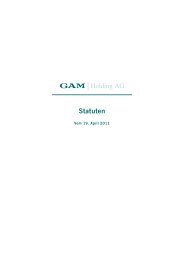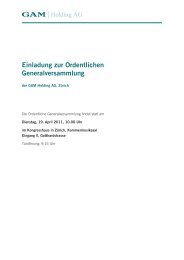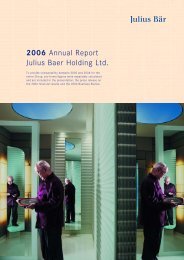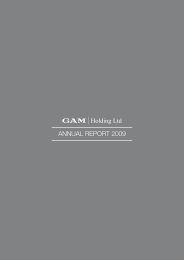2005 Annual Report Julius Baer Holding Ltd. - GAM Holding AG
2005 Annual Report Julius Baer Holding Ltd. - GAM Holding AG
2005 Annual Report Julius Baer Holding Ltd. - GAM Holding AG
You also want an ePaper? Increase the reach of your titles
YUMPU automatically turns print PDFs into web optimized ePapers that Google loves.
Hedges<br />
The Group hedges a portion of interest rate risk associated<br />
with cash flows resulting from term deposits<br />
or term loans by employing interest rate swaps. The<br />
market value of these swaps on 31 December <strong>2005</strong><br />
amounted to a net CHF –1.0 million.<br />
On 31 December <strong>2005</strong>, the Group carried no fair<br />
value hedges on its books.<br />
6. Operational risks<br />
6.1. Operational risk framework and process<br />
We define operational risk as the potential occurrence<br />
of losses as a result of the inappropriateness<br />
or failure of internal procedures, personnel and systems<br />
or due to external events. This framework also<br />
includes regulatory and supervisory risks.<br />
Within this context, in its paper Sound Practices for<br />
the Management and Supervision of Operational Risk<br />
the Basel Committee formulates qualitative standards<br />
regarding organizational structure and risk management<br />
as well as quantitative guidelines for identifying<br />
and measuring operational risks. We already adhere<br />
to these standards today while preparing for the<br />
demands of the future by implementing targeted<br />
measures and taking a proactive approach.<br />
The department Group Risk Management Operational<br />
Risk has Group-wide responsibility for developing and<br />
implementing an internal framework for steering<br />
operational risk (excluding legal risks and compliance<br />
risks), which includes guidelines and methods for<br />
identification and early detection of risks as well as<br />
the definition of appropriate reporting structures for<br />
achieving timely and efficient management reporting.<br />
In addition, this department coordinates all topics<br />
associated with operational risk in order to chronicle<br />
and illuminate these topics throughout the Group as<br />
well as to be able to minimize the potential financial<br />
consequences from operational risks by taking appro-<br />
priate measures. The objectives of operational risk<br />
management are as follows:<br />
Notes<br />
– Avoiding potential substantial losses<br />
– Reinforcing a high degree of risk awareness at all<br />
levels<br />
– Reinforcing an efficient early warning system<br />
– Reinforcing the existing “culture of risk awareness,<br />
risk responsibility and risk control”<br />
– Assessing all operational risk issues before new<br />
services or products are offered by the organization<br />
– Assuring the smooth operation of business in the<br />
event of infrastructure breakdowns and catastrophes<br />
by regularly monitoring and updating the<br />
business recovery plan as well as the crisis management<br />
preparations within the scope of effective<br />
Business Continuity Management (BCM)<br />
The goal of BCM is to ensure that precautionary<br />
measures are in place to mitigate the vulnerability for<br />
interruption of vital business functions due to natural<br />
disasters, catastrophic events and other events over<br />
which businesses have no control such as fire, earthquake,<br />
terrorist attacks, war, floods and epidemics.<br />
Therefore respective directives and standards are in<br />
place.<br />
If a catastrophic event occurs, an Emergency Management<br />
Team (EMT) consisting of pre-determined<br />
members will convene with the purpose of ensuring<br />
that <strong>Julius</strong> <strong>Baer</strong> Group reacts to any catastrophic<br />
event in a way that minimizes any interruption to the<br />
business. The EMT investigates the origin, and<br />
assesses the effects of potentially catastrophic<br />
events and is responsible for identifying and implementing<br />
adequate counter-measures. The EMT is supported<br />
by several sub-committees, responsible for,<br />
among other things, taking emergency measures,<br />
gathering information and resuming business. Each<br />
branch has its own emergency organization, tailormade<br />
to the size of the branch. All local EMTs are<br />
supported by the main team in Zurich. All processes<br />
JULIUS BAER GROUP 91












